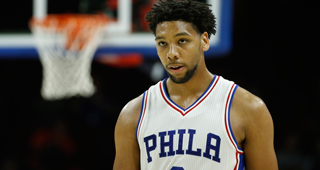Rookie Scale Contracts are primarily detailed in Article VIII of the 2017 Collective Bargaining Agreement.
Who has a rookie scale contract?
Only first round draft picks are subject to the rookie scale, which has contract values laid out in the CBA, unless they still have not signed three years after their draft, and both the player and the team that holds their rights agree to a non-rookie scale contract. The most recent occurrence of this was Bogdan Bogdanovic signing with Sacramento at above the rookie scale amount in 2017.
What is the structure of rookie scale contracts?
While the salary changes based on draft slot and players can be signed for as much as 120 percent or as little as 80 percent of the scale, every rookie scale contract has the same structure. The first two seasons are fully guaranteed and the final two seasons are team options. The team holding the player’s rights at the end of that fourth season can extend a qualifying offer to make them a restricted free agent, a difference from non-rookie scale players who become unrestricted free agents with their fourth season of NBA experience. Also, in the current CBA rookie scale contracts are the only ones allowed to have multiple option years.
What happens if a player does not join the NBA immediately after being drafted?
A player drafted in the first round who starts his NBA career in a later season but who still signs a rookie scale contract will be paid according to the rookie scale of the year he joins the league. For example, the Minnesota Timberwolves drafted Ricky Rubio fifth overall in 2009 but the Spaniard was paid the same as the fifth pick of the 2011 Draft (Jonas Valanciunas) when he came over.
How are the team options in a rookie scale contract different than other contracts?
Beyond having specified amounts and calculations included in the CBA itself, the biggest difference between rookie scale options and other team options is the decision timing. Most other options have a decision time in June (before the league year turns over July 1 but after the end of the NBA Finals, typically) but teams must decide on rookie scale options on or before October 31 of the year before. That means front offices are picking up or declining a player’s third season option early in his second season and the fourth season option a few weeks into their third campaign.
Unsurprisingly, that totally changes the decision-making process for teams because they have a less clear idea of the offseason to come and how good they expect the player in question to be for that option season. This timing, the relative value of rookie scale contract and front offices believing in the players they draft (or choose to acquire) leads to a larger portion of rookie scale options getting picked up than would happen otherwise.
What happens when a team declines a rookie scale option?
Since option years are decided so far ahead of time, a player is still under contract for that season if a team declines a rookie scale option. The most important rule comes into play the following summer. While declining the option makes that player an unrestricted free agent that off-season, the team and player could agree to a new contract. However, only the team had said player’s rights at the end of that season has an additional restriction: they cannot sign him for a higher first year salary than the value of the declined option.
This rule is aimed at limiting a form of circumvention but interestingly applies to the team that holds the player’s rights at the end of that season whether or not they were the ones to decline the option. The most famous example of this is Austin Rivers, who could not sign with the Clippers for more than his declined option even though the Pelicans made that decision and he was traded twice during that intervening season. Rivers still re-signed with his father’s team within the specified parameters, then earned a higher salary by opting out of that contract the following offseason once the restriction no longer applied.
Who decides on a player’s rookie scale option if he is traded?
Any team that holds a player’s rights can decide on a rookie scale option as long as they do so before the October 31st deadline. That means a team could trade a player before or after making a decision. Intuitively, the receiving team would prefer the flexibility to make their own choice.
Did rookie scale contracts change in the new CBA?
Not significantly and that actually created an fascinating, important new situation. The October 31 decision deadline for rookie scale options used to line up with the early portion of the NBA regular season but the league moving up the start of the season means teams have more regular season games before having to decide on rookie scale options.
This could prove relevant in the case of injuries (or even an issue like Bobby Portis punching Nikola Mirotic) or early ineffectiveness in games that count. Since the 17-18 season is the first with this new dynamic, we will have to see how it affects option decisions.
What are the most interesting rookie scale option decisions this October?
Jahlil Okafor (Philadelphia), Mario Hezonja (Orlando), Rashad Vaughn (Milwaukee), Jarell Martin (Memphis), Chris McCullough (Washington), Kevon Looney (Golden State) and Brice Johnson (LA Clippers)
Will the rookie scale option system change in the future?
The structure itself appears firmly entrenched, especially after the new CBA changed the salary calculations but retained the rookie scale contract format. If a change happens, it will be on the decision date for the option years but that would be a long time from now.



